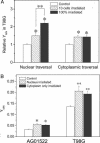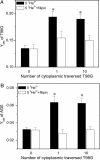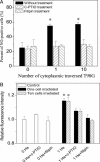Targeted cytoplasmic irradiation induces bystander responses
- PMID: 15345742
- PMCID: PMC518785
- DOI: 10.1073/pnas.0404930101
Targeted cytoplasmic irradiation induces bystander responses
Abstract
The observation of radiation-induced bystander responses, in which cells respond to their neighbors being irradiated, has important implications for understanding mechanisms of radiation action particularly after low-dose exposure. Much of this questions the current dogma of direct DNA damage driving response in irradiated systems. In this study, we have used a charged-particle microbeam to target individual helium ions ((3)He(2+)) to individual cells within a population of radioresistant glioma cells cultured alone or in coculture with primary human fibroblasts. We found that even when a single cell within the glioma population was precisely traversed through its cytoplasm with one (3)He(2+) ion, bystander responses were induced in the neighboring nonirradiated glioma or fibroblasts so that the yield of micronuclei was increased by 36% for the glioma population and 78% for the bystander fibroblast population. Importantly, the yield of bystander-induced micronuclei was independent of whether the cytoplasm or nucleus of a cell was targeted. The bystander responses were fully eliminated when the populations were treated with 2-(4-carboxyphenyl)-4,4,5,5-tetramethyl-imidazoline-1-oxyl-3-oxide or filipin, which scavenge nitric oxide (NO) and disrupt membrane rafts, respectively. By using the probe 4-amino-5-methylamino-2',7'-difluorofluorescein, it was found that the NO level in the glioma population was increased by 15% after 1 or 10 cytoplasmic traversals, and this NO production was inhibited by filipin. This finding shows that direct DNA damage is not required for switching on of important cell-signaling mechanisms after low-dose irradiation and that, under these conditions, the whole cell should be considered a sensor of radiation exposure.
Figures




References
-
- Morgan, W. F. (2003) Oncogene 22, 7094–7099. - PubMed
-
- Deshpande, A., Goodwin, E. H., Bailey, S. M., Marrone, B. L. & Lehnert, B. E. (1996) Radiat. Res. 145, 260–267. - PubMed
-
- Nagasawa, H. & Little, J. B. (1999) Radiat. Res. 152, 552–557. - PubMed
-
- Seymour, C. B. & Mothersill, C. (1997) Radiat. Oncol. Investig. 5, 106–110. - PubMed
-
- Limoli, C. L., Ponnaiya, B., Corcoran, J. J., Giedzinski, E., Kaplan, M. I., Hartmann, A. & Morgan, W. F. (2000) Adv. Space Res. 25, 2107–2117. - PubMed
Publication types
MeSH terms
Substances
LinkOut - more resources
Full Text Sources

